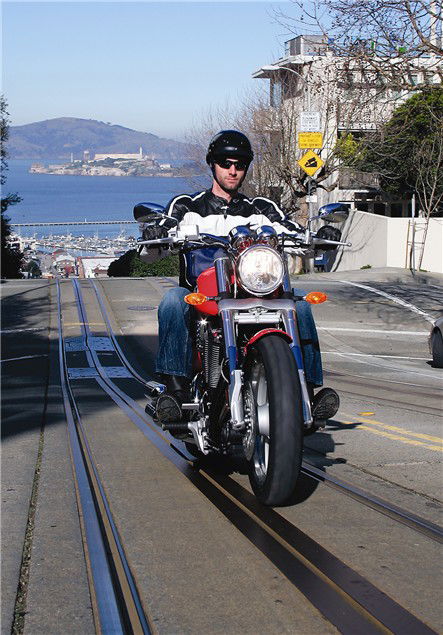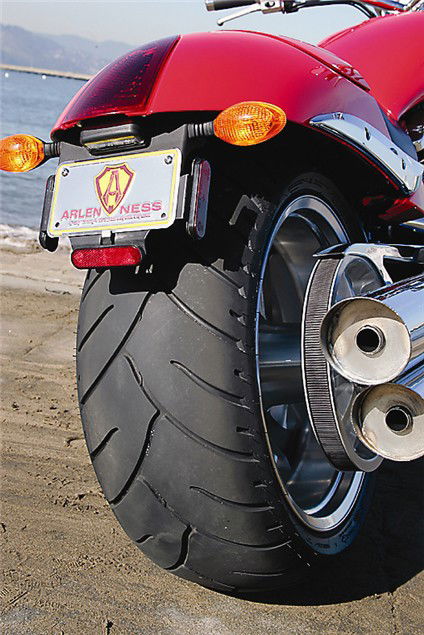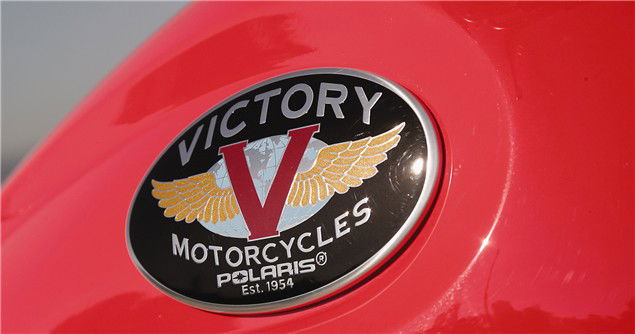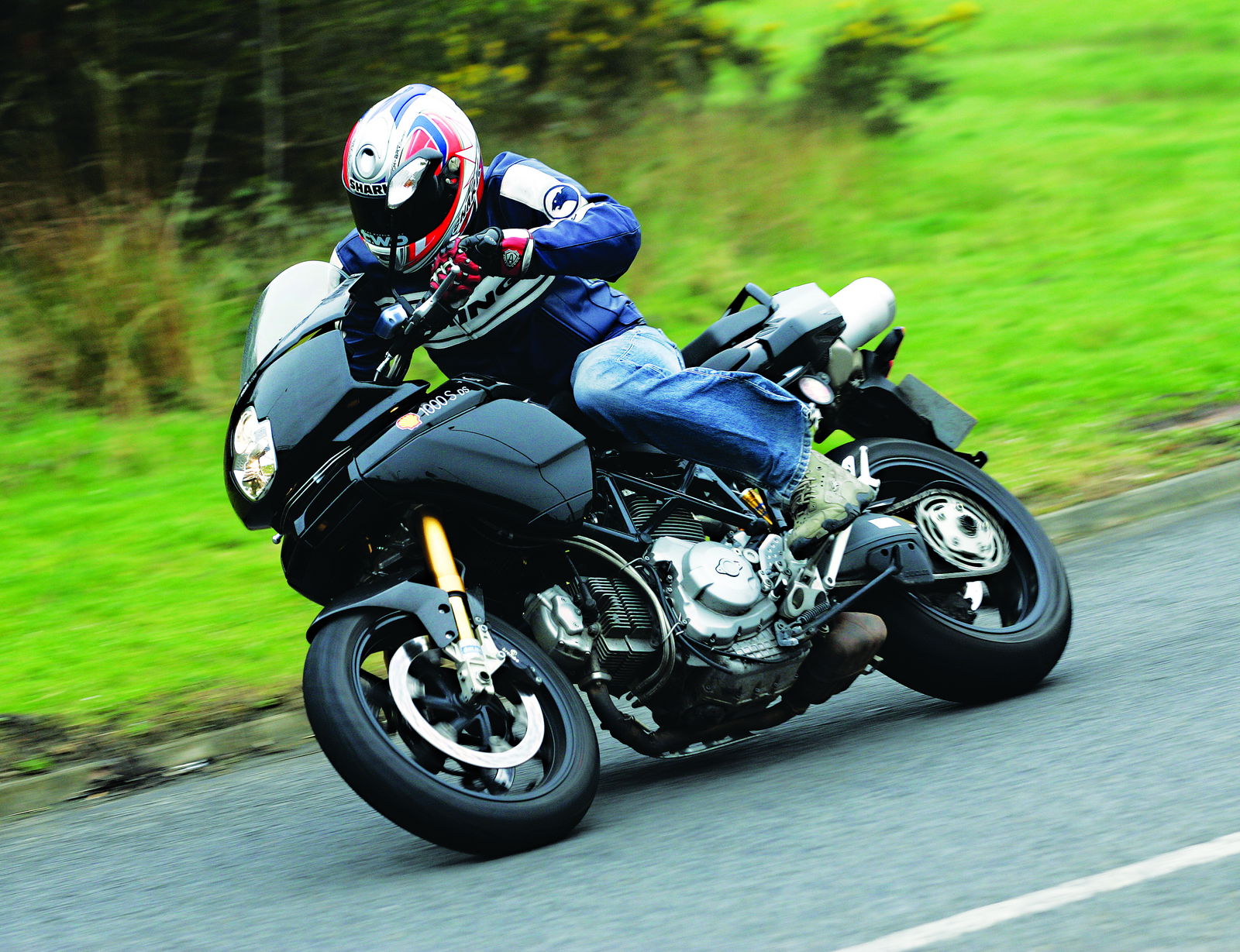Road Test: Victory Hammer
A new engine, an overdrive and the fattest rear tyre in biking-dom. Will Victory's Hammer be able to wrestle the performance cruiser crown from our home-grown Rocket III?

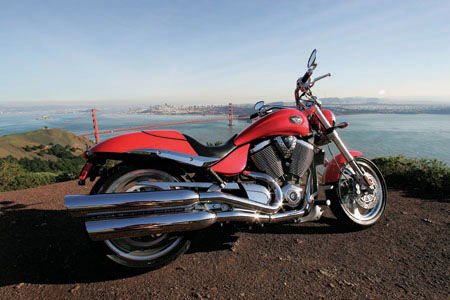 |
Picture the scene. Golden Gate Bridge and the haunting spectacle of Alcatraz prison sparkle in the sun as the squawking of seagulls wafts up from Fishermans Wharf. Then a deafening crescendo of open-mouthed V-twin splits the morning quiet as two Victory motorcycles appear, riders blipping throttles as the deep whup-whup of the engines reverberates in the air. One bike is an Arlen Ness Kingpin special, the other a new Victory Hammer.
Sorry to rub it in, but that was me on the brand new Hammer, picked up from the Arlen Ness HQ in Dublin, California, earlier that day. Victory is serious about becoming the next big household name in the cruiser world, and their range is slowly growing to suit.This bike, the Hammer, is now their fifth model.
First impressions of the Hammer as it sat amid a shop floor teeming with chopper specials was that it looked a bit plain-Jane. From the front the view is dominated by the inverted forks and headlight, but strolling up to her booty the impression is somewhat different. The trademark curvaceous Victory lines are there, and the addition of a single seat pod transforms the look from two-up ride to more of a menacing street rod. The twin clocks remain; they are simple to read and contain all the necessary info (apart from the time of day). The new V-shaped bars are set lower than before, adding to the street rod look and also giving greater control, while the seat is wide and plush.
The most striking aspect, however, is the rear tyre - the first 250-section rubber seen on a production motorcycle and eclipsing the 240-section record held by Triumph's Rocket III for the past eight months. There are a couple a reasons for the tyre. Aesthetics come into play; from the back the fat rubber makes the Hammer look squat and purposeful. The other reason is to counter-balance the Hammer's increased rake and shortened wheelbase to maintain straight-line stability - the tyre is so fat you could almost forget the sidestand and leave the Hammer standing upright unaided.
Fumbling for the ignition (it's on the left-hand side of the engine), I pulled out onto Dublin Boulevard heading towards the Interstate for the Hammer's first real test. Admittedly not a particularly fair test as cruisers aren't designed for high-speed motorway work, but a necessary evil to get back into San Francisco. As it turned out the new 100 cubic-inch Freedom engine worked a treat. Opening up and slipping up through the (non) clunky box into overdrive, we cruised back towards Bay Bridge. The increase in power and torque over the previous 92 cubic-inch motor was evident instantly, and the addition of a sixth gear overdrive is actually a brilliant idea for motorway cruising.
The Hammer purrs like a contented tiger at a steady 70mph but crack the throttle and an extra surge of torque propels you forward at a reasonable pace. It pulls hard from around 2000rpm and I could comfortably hit a ton-ten without too much neck strain - and it felt good for at least another 10mph. To keep the increased power in check, the Hammer is fitted with twin discs and radially-mounted four-pot Brembos. These bite superbly, and just as well as the rear is almost non-existent.
Hitting the streets of San Francisco I realised the Hammer was built for the open roads and A-road heaven. The clutch is very heavy and, unless you enrol in a gym before buying a Hammer, your hands and wrists will ache with constant gear changes. Coupled with a slightly twitchy fuel injection, it makes a lot of clutch slip necessary when pulling away from a standstill. But this can just add to the fun: grab a big handful, dump the clutch and let the rear spin up, leaving a burning trail of rubber from the lights. Works every time.
Park up and the crowds flock to look at the Hammer. Victory has come up trumps again with a stunning looking motorcycle. Perhaps not in a conventional cruiser sense though, more of a 'what is that?!'way.
Cory Ness, design guru and son of Arlen, was in when we rolled back to the showroom. "We didn't have too much say in the design of the 2005 Hammer," he said, "but we're in collaborations with Victory for the design of a '06 derivative."
Arlen Ness has already toyed with the idea of bumping up the already gigantic rear rubber from a 250- to 280-section, lowering the back end and building an aftermarket exhaust to breathe more life into the engine.
Victory's aim is to battle Harley as leader of the cruiser pack. Its engines are bigger, its bikes cheaper (just) and, on the whole, better built than the Milwaukee muscle.
VERDICT
A new motor, loads of torque and mean good looks make the Hammer a real alternative to the best H-D have to offer
SPECS
TYPE - MUSCLE CRUISER
PRODUCTION DATE - 2005
PRICE NEW - £12,595
ENGINE CAPACITY - 1634cc
POWER - 89bhp@4500rpm
TORQUE - 110lb.ft@2500rpm
WEIGHT - 298kg
SEAT HEIGHT - 669mm
FUEL CAPACITY - 17L
TOP SPEED - 120mph
0-60 - n/a
TANK RANGE - N/A
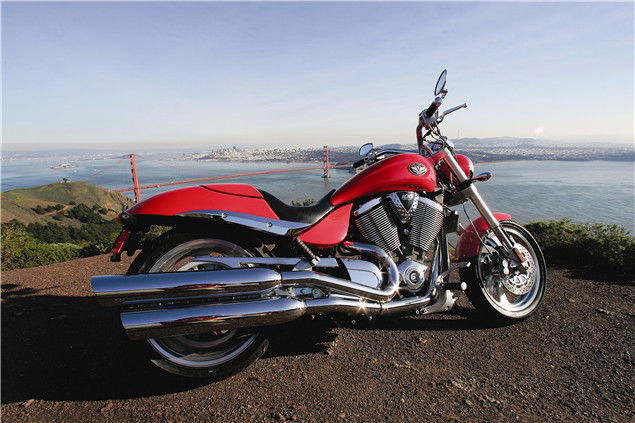
Picture the scene. Golden Gate Bridge and the haunting spectacle of Alcatraz prison sparkle in the sun as the squawking of seagulls wafts up from Fishermans Wharf. Then a deafening crescendo of open-mouthed V-twin splits the morning quiet as two Victory motorcycles appear, riders blipping throttles as the deep whup-whup of the engines reverberates in the air. One bike is an Arlen Ness Kingpin special, the other a new Victory Hammer.
Sorry to rub it in, but that was me on the brand new Hammer, picked up from the Arlen Ness HQ in Dublin, California, earlier that day. Victory is serious about becoming the next big household name in the cruiser world, and their range is slowly growing to suit. This bike, the Hammer, is now their fifth model.
First impressions of the Hammer as it sat amid a shop floor teeming with chopper specials was that it looked a bit plain-Jane. From the front the view is dominated by the inverted forks and headlight, but strolling up to her booty the impression is somewhat different. The trademark curvaceous Victory lines are there, and the addition of a single seat pod transforms the look from two-up ride to more of a menacing street rod. The twin clocks remain; they are simple to read and contain all the necessary info (apart from the time of day). The new V-shaped bars are set lower than before, adding to the street rod look and also giving greater control, while the seat is wide and plush.
The most striking aspect, however, is the rear tyre - the first 250-section rubber seen on a production motorcycle and eclipsing the 240-section record held by Triumph's Rocket III for the past eight months. There are a couple a reasons for the tyre. Aesthetics come into play; from the back the fat rubber makes the Hammer look squat and purposeful. The other reason is to counter-balance the Hammer's increased rake and shortened wheelbase to maintain straight-line stability - the tyre is so fat you could almost forget the sidestand and leave the Hammer standing upright unaided.
Fumbling for the ignition (it's on the left-hand side of the engine), I pulled out onto Dublin Boulevard heading towards the Interstate for the Hammer's first real test. Admittedly not a particularly fair test as cruisers aren't designed for high-speed motorway work, but a necessary evil to get back into San Francisco. As it turned out the new 100 cubic-inch Freedom engine worked a treat. Opening up and slipping up through the (non) clunky box into overdrive, we cruised back towards Bay Bridge. The increase in power and torque over the previous 92 cubic-inch motor was evident instantly, and the addition of a sixth gear overdrive is actually a brilliant idea for motorway cruising.
The Hammer purrs like a contented tiger at a steady 70mph but crack the throttle and an extra surge of torque propels you forward at a reasonable pace. It pulls hard from around 2000rpm and I could comfortably hit a ton-ten without too much neck strain - and it felt good for at least another 10mph. To keep the increased power in check, the Hammer is fitted with twin discs and radially-mounted four-pot Brembos. These bite superbly, and just as well as the rear is almost non-existent.
Hitting the streets of San Francisco I realised the Hammer was built for the open roads and A-road heaven. The clutch is very heavy and, unless you enrol in a gym before buying a Hammer, your hands and wrists will ache with constant gear changes. Coupled with a slightly twitchy fuel injection, it makes a lot of clutch slip necessary when pulling away from a standstill. But this can just add to the fun: grab a big handful, dump the clutch and let the rear spin up, leaving a burning trail of rubber from the lights. Works every time.
Park up and the crowds flock to look at the Hammer. Victory has come up trumps again with a stunning looking motorcycle. Perhaps not in a conventional cruiser sense though, more of a 'what is that?!'way.
Cory Ness, design guru and son of Arlen, was in when we rolled back to the showroom. "We didn't have too much say in the design of the 2005 Hammer," he said, "but we're in collaborations with Victory for the design of a '06 derivative."
Arlen Ness has already toyed with the idea of bumping up the already gigantic rear rubber from a 250- to 280-section, lowering the back end and building an aftermarket exhaust to breathe more life into the engine.
Victory's aim is to battle Harley as leader of the cruiser pack. Its engines are bigger, its bikes cheaper (just) and, on the whole, better built than the Milwaukee muscle.
VERDICT
A new motor, loads of torque and mean good looks make the Hammer a real alternative to the best H-D have to offer.
Victory Hammer Specs
TYPE - MUSCLE CRUISER
PRODUCTION DATE - 2005
PRICE NEW - £12,595
ENGINE CAPACITY - 1634cc
POWER - 89bhp@4500rpm
TORQUE - 110lb.ft@2500rpm
WEIGHT - 298kg
SEAT HEIGHT - 669mm
FUEL CAPACITY - 17L
TOP SPEED - 120mph
0-60 - n/a
TANK RANGE - N/A
